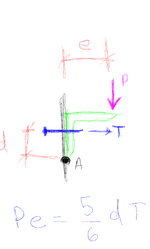see_gen_notes
Civil/Environmental
I'm struggling to wrap my head around this concept. Suppose I have a ledger angle with a load acting downward (in the direction of gravity) at the end of its leg. When using anchor design software, should I account for both the tension caused by prying and the shear from the load? Or is failure evaluated as either prying or shear, but not both simultaneously? My boss insists on the latter approach but didn’t provide much explanation—more of a statement than reasoning. I feel like there’s some shear happening in reality, but is it negligible compared to the prying force? And vice versa?

